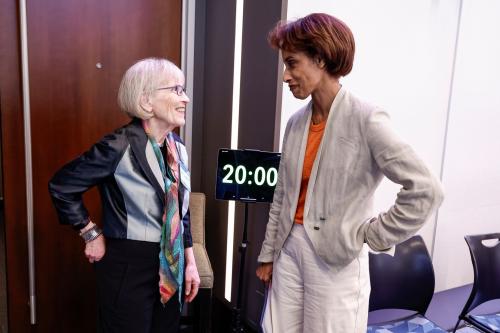

Past Event
Content from the Brookings Institution India Center is now archived. After seven years of an impactful partnership, as of September 11, 2020, Brookings India is now the Centre for Social and Economic Progress, an independent public policy institution based in India.
Brookings India, the American Center, and the United States-India Educational Foundation co-hosted a discussion on the challenges associated with universal pension schemes and health security. The event featured the work of two researchers – Brookings India Fellow Prof. Shamika Ravi, and Prof. Ken Apfel, Fulbright-Nehru Senior Scholar. Apfel’s presentation provided a macro perspective on the health sector in the United States and India, and included lessons for India from the American experience. Ravi discussed the micro aspects of health insurance, sharing her findings on the impact of various state-funded insurance schemes and drawing lessons from microfinance.
The discussion was embedded in an overarching understanding that health coverage in India must be restructured and expanded. According to WHO reports, among countries with national health insurance programs, India has one of the highest out-of-pocket healthcare spending, indicating that there are gaps in the current programs that must be ameliorated. Based on this, a number of issues emerged with policy implications:
Need for better governance of insurance:
One of the most significant lessons from the United States’ experience is the importance of a strong public governance system to ensure health quality at a reasonable cost. Such governance is particularly important in the public-private model used in the United States, and increasingly in India. Hitherto, the governance of insurance has not received much attention in India – the central and state governance apparatus is fragmented, and insurance is overseen by very small ‘nodal’ agencies. Additionally, existing insurance schemes have been criticized for producing perverse incentives that cause health providers to expand services, implying that in the absence of oversight and accountability, costs are expected to see a huge increase in the future.
The governance of insurance, however, is just one aspect in the much larger healthcare service delivery framework. Overall, the healthcare sector requires greater oversight and monitoring to ensure equitable access to high quality services, and ethical behavior by all stakeholders in the process. Mechanisms must also be put in place to ensure that the overutilization of services is prevented and costs are contained.
Insurance coverage is not in line with health burden:
A significant lacuna in the current insurance framework is that almost all state sponsored insurance schemes cover only secondary and tertiary care, whereas people spend much more on primary care. As the table below demonstrates, people spend much more on OPD than they do on institutional care. Additionally, majority of their spending is on drugs and medicines, which is not covered by insurance. The Yeshasvini Cooperative Farmers Scheme, the Rajiv Aarogyasri Health Insurance Scheme, the Chief Minister Kalaignar’s Insurance Scheme, and the Vajpayee Arogyashri Scheme, all cover mainly tertiary care, while the Rashtriya Swasthya Bima Yojana covers mainly secondary care.

Underutilization of Insurance and Need for Financial Literacy:
India has witnessed a significant increase in insurance coverage in a relatively short time, from 6% of the population (in 2007) to 25% (in 2010). But even though the insurance cover has increased, enrolment and utilization rates remain low. While this stems in large part from the aforementioned point about insurance policies covering only secondary and tertiary care, it may also be attributed to the lack of awareness or knowledge about insurance policies. Insurance is a much more sophisticated financial instrument than credit and savings, and outcomes are known to improve over a period of time.
Research on microfinance reiterates this – not only are microfinance borrowers are more likely to file health insurance claims than their spouses, but first time clients are significantly less likely to file claims than older clients. All of this points to the critical role of financial literacy and awareness in improving health insurance utilization.
Need for pension reforms
While health insurance as a concept is rapidly gaining ground in India, there is still limited discussion on the need for reforms in the area of universal pension. Apfel made the case for pension reforms in India, explaining that while India has a relatively young population, this population is also rapidly aging, with the elderly growing at a greater rate than the young. In addition, the country is also moving away from the long tradition of family-based support for the elderly. Current pension systems are inadequate – in both the formal and informal workforce. For the former, while systems are in place, they show signs of stress. The informal workforce, on the other hand – which accounts for 90% of the total workforce – has immensely limited instituted social assistance programs, and those that exist are targeted at the very poor. Additionally, only a very small part of the informal workforce is participating in retirement savings schemes.
So, on the one hand, India needs to find a way to expand retirement savings for the informal workforce, but on the other, these savings also need to be supplemented with public support, in the form of social pensions.
Universalizing pensions and health coverage is costly:
Finally, insurance and pension schemes are very costly propositions. The increase in the insurance and pension cover in the United States has come at a significant cost; for instance, social security expenditure has increased from 2% of the GDP (in 1960) to 4% (in 2000), and expected to touch 5% (in 2020). Similarly, USG Health Insurance, which was at zero in 1960, accounted for 3% of the GDP in 2000, and could go up to 7% by 2020.
For India, the total expenditure on pension and health security is expected to increase to 5-6% of the GDP, on account of universal health coverage, and social pensions and retirement savings. But eventually, such costs yield significant benefits. In the American experience, for instance, the elderly poverty rate has declined sharply from 35% in 1960 to 10% in 2000, and is expected to fall further by 2020.

Quinn Sanderson
July 9, 2024

Stuart M. Butler
May 23, 2024

Jack A. Smalligan
May 14, 2024